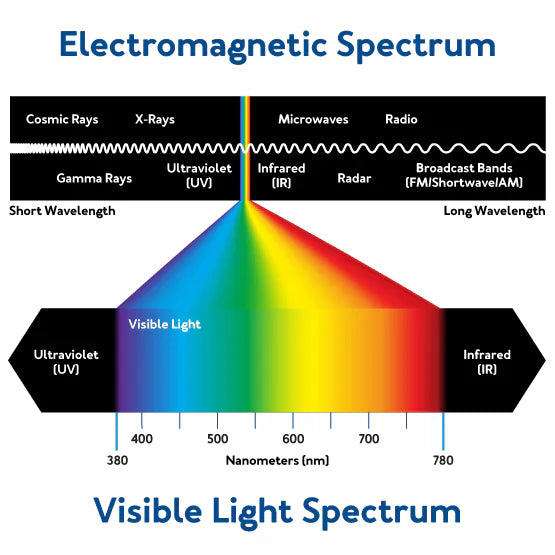
The Hidden Cost of Blue Light: How Evening Light Disrupts Your Hormones and Mood
We evolved under the rhythm of the sun — bright, full-spectrum light by day and soft, warm darkness by night.
But in today’s world of screens, artificial lighting, and long evenings indoors, that rhythm has been broken.
At the center of that disruption lies one culprit: blue light.
🔵 What Is Blue Light, and Why Does It Matter?
Blue light is part of the visible light spectrum with a short wavelength (around 450–495 nm) and high energy.
During the day, it’s essential — it boosts alertness, focus, and reaction time. But at night, artificial blue light from phones, LED lights, and laptops sends a confusing message to your brain:
“It’s still daytime. Stay awake.”
Your body responds by suppressing melatonin, the hormone that tells you it’s time to sleep. This throws your circadian rhythm out of sync, affecting far more than just rest.
🧠 Blue Light, Hormones, and the Sleep–Wake Cycle
Melatonin isn’t just a sleep hormone — it’s a master regulator of hormonal balance.
It influences your thyroid, cortisol levels, insulin sensitivity, and even reproductive hormones.
When melatonin production drops because of evening blue light exposure, your body stays in a daytime stress mode, increasing cortisol and reducing deep restorative sleep.
Over time, this leads to:
-
Hormonal imbalances (especially cortisol–melatonin disruption)
-
Poor energy and mood regulation
-
Increased sugar cravings and weight gain
-
Weakened immune function
In essence, evening blue light doesn’t just rob you of sleep — it deregulates your entire hormonal orchestra.
❄️ Seasonal Depression and Short Winter Days
In northern climates, where daylight hours are short and the sun sits low during winter, people often experience Seasonal Affective Disorder (SAD) — a form of depression linked to light deficiency.
When you don’t get enough natural morning sunlight and are overexposed to artificial blue light at night, your brain’s serotonin and dopamine levels drop.
This imbalance affects not only your mood but also your circadian rhythm, making mornings sluggish and nights restless.
Studies have shown that morning light exposure combined with blue-light blocking in the evening significantly improves both sleep and mood during the darker months (Lam et al., The American Journal of Psychiatry, 2006).
🌞 Light Hygiene: Restoring Your Natural Rhythm
Your body’s biology follows the solar clock, not the artificial one.
Here’s how to reset your rhythm naturally:
-
Morning light, every day: Get outside within an hour of waking — even on cloudy days. Natural light is 100x stronger than indoor lighting.
-
Block blue light at night: Use amber or red-tinted glasses after sunset, or switch to warm, low-temperature lighting (below 2700K).
-
Dim screens: Enable “night mode” and reduce brightness two hours before bed.
-
Hydrate wisely: Structured, mineral-rich water (like AuroLiquidGold) helps maintain electrical balance and circadian communication between cells.
-
Sleep in darkness: Even small light sources can suppress melatonin — blackout curtains or a sleep mask make a huge difference.
⚡ The Quantum Connection: Light, Water, and Mood
In quantum biology, light and water are inseparable partners.
Your cells use water to store and transfer photonic energy — meaning light literally charges your biology.
At night, when artificial blue light floods your eyes, it interferes with the biophotonic communication between your brain, hormones, and mitochondria.
Pairing natural light exposure during the day with structured hydration (AuroLiquidGold) keeps that system coherent — improving both mood and metabolic balance, even through dark winter months.
✨ The Takeaway
Your body is designed to dance with the light of the sun — not the glare of screens.
By blocking blue light at night and embracing natural light by day, you align your hormones, restore deep sleep, and protect your mood through every season.
True balance begins when light, water, and rhythm move as one.
📚 Scientific References
-
Cajochen, C. et al. (2005). “Role of blue light and the human circadian system.” Journal of Sleep Research.
-
Lam, R. W. et al. (2006). “Light therapy for seasonal affective disorder.” The American Journal of Psychiatry.
-
LeGates, T. A. et al. (2014). “Light as a central modulator of circadian rhythms, sleep, and affect.” Nature Reviews Neuroscience.
-
Brainard, G. C. et al. (2001). “Action spectrum for melatonin regulation in humans: evidence for a novel circadian photoreceptor.” The Journal of Neuroscience.
-
Pollack, G. H. (2013). The Fourth Phase of Water: Beyond Solid, Liquid, and Vapor. Ebner and Sons.
